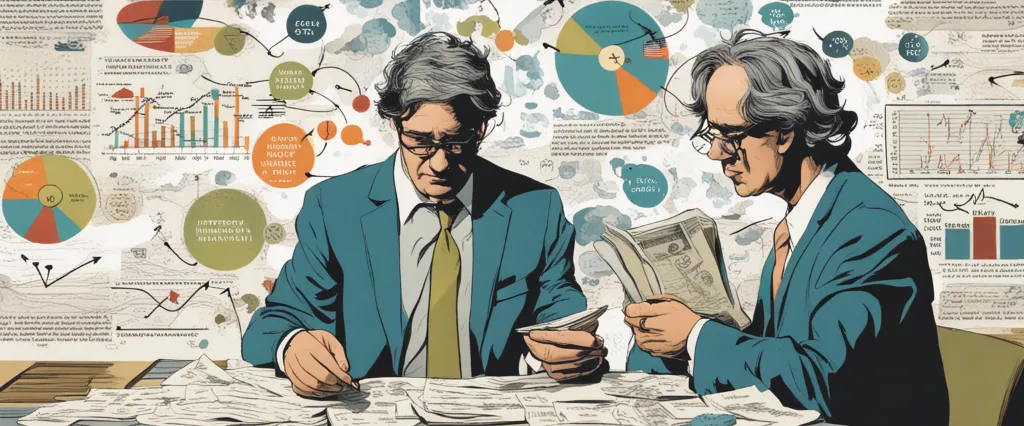In “Mastering the Market Cycle,” acclaimed investor and author Howard Marks provides a comprehensive and in-depth analysis of the cyclical nature of financial markets. With a career spanning several market cycles and renowned for his insightful memos to investors, Marks offers invaluable wisdom and actionable advice for navigating through inevitable market downturns. Drawing from his vast experience and expertise, Marks explores the key factors that drive market cycles, highlighting the importance of understanding and being able to anticipate their patterns. Through his engaging writing style and real-world examples, Marks empowers readers to become more astute investors, capable of recognizing market cycles and capitalizing on the opportunities they present.
Chapter 1: The Importance of Market Cycles
Chapter 1 of the book “Mastering the Market Cycle” by Howard Marks emphasizes the significance of understanding and navigating market cycles. Marks explains that market cycles, characterized by alternating periods of boom and bust, are an inherent aspect of investing. These cycles can have a profound impact on investment outcomes and can be influenced by psychological factors and economic conditions.
Marks highlights the importance of recognizing the existence of market cycles and avoiding the mistaken belief in their permanence. He argues that the failure to understand and anticipate market cycles has led to significant losses for investors throughout history. Successful investors, however, are those who grasp the concept of cycles and take advantage of opportunities that emerge within them.
The author suggests several key insights to grasp the concept of market cycles. Firstly, understanding that investor psychology often swings between fear and greed during market extremes can help predict the direction of future market movements. Secondly, being aware of the relationship between asset prices and underlying fundamentals is crucial. Market cycles can result from the disconnect between these two factors, as seen in the tech bubble of the late 1990s.
Lastly, Marks emphasizes the importance of avoiding the fallacy of extrapolation, which occurs when investors assume that current trends will continue indefinitely. Instead, one should recognize that market cycles are cyclical and that excessive optimism or pessimism can lead to mispriced assets.
In conclusion, Chapter 1 of “Mastering the Market Cycle” stresses the significance of market cycles in investment decision-making. Understanding the behavioral and economic dynamics that drive these cycles is vital for successful investing and avoiding potential pitfalls.
Chapter 2: The Psychology of Market Cycles
Chapter 2 of “Mastering the Market Cycle” by Howard Marks, titled “The Psychology of Market Cycles,” delves into the behavioral aspects that underpin the recurring patterns observed in market cycles. Marks stresses the significance of understanding investor psychology as a key factor in comprehending market cycles and making informed investment decisions.
Marks begins by emphasizing the role of investor psychology in gasoline fueling market cycles. He highlights the two primary forces that drive market fluctuations: the pendulum of investor psychology swinging between fear and greed, and the fickleness of the crowd, leading to overreaction or underreaction to perceived market conditions.
Marks then explores various psychological biases that contribute to market cycles. He discusses the emotions of fear and greed and their impact on investors’ decision-making processes. Fear drives investors to overreact during market downturns, selling assets at irrational prices, while greed leads to overconfidence, excessive risk-taking, and inflated asset valuations.
The chapter also addresses the role of mental shortcuts, such as confirmation bias and herd behavior, in perpetuating market cycles. Confirmation bias causes investors to seek information that aligns with their preconceived notions, ignoring contradictory evidence. Herd behavior amplifies the impact of psychological biases, as investors tend to follow the crowd rather than critically analyzing market data.
Marks concludes the chapter by emphasizing the importance of self-awareness, rational thinking, and disciplined investing. He highlights the significance of recognizing and managing one’s own psychological biases to navigate the inherent volatility of market cycles effectively.
In summary, Chapter 2 of “Mastering the Market Cycle” sheds light on the psychological aspects that drive market cycles. By understanding the forces of fear, greed, and herd behavior, investors can gain insights into market patterns and make more informed investment decisions. Self-awareness and rational thinking are crucial in managing psychological biases and avoiding the pitfalls of emotional decision-making.
Chapter 3: The Drivers of Market Cycles
Chapter 3 of “Mastering the Market Cycle” by Howard Marks delves into the various drivers that contribute to market cycles. Marks emphasizes the importance of understanding these drivers in order to effectively navigate the ups and downs of the market.
Marks begins by identifying four main causes of market cycles: economic fluctuations, investor psychology, government influence, and the availability of credit. Economic fluctuations occur due to the typical rhythms of the business cycle, with periods of expansion followed by contraction. Investor psychology plays a significant role in market cycles as people’s emotions and behavior drive buying and selling decisions. Government actions, such as fiscal and monetary policies, also impact market cycles. Lastly, the availability of credit can stimulate or contract the economy, affecting market cycles.
Marks further explores how these four drivers interact with and reinforce each other. For example, economic fluctuations can influence investor psychology, as people tend to be more optimistic during an expansion and more fearful during a contraction. Similarly, government actions can either exacerbate or mitigate the fluctuations in the economy and investor behavior.
It is also highlighted that market cycles often become self-fulfilling prophecies. During periods of expansion, optimism leads to increased investment, driving prices higher. Conversely, during periods of contraction, fear causes investors to sell, leading to price declines.
Marks concludes the chapter by emphasizing the importance of understanding and analyzing these drivers to anticipate market cycles. By recognizing economic factors, investor sentiment, government influence, and credit availability, investors can position themselves to take advantage of opportunities during market swings. He encourages readers to carefully assess these drivers and avoid getting caught up in the excitement or panic of the market.
Chapter 4: Assessing Market Cycles

Chapter 4 of “Mastering the Market Cycle” by Howard Marks is titled “Assessing Market Cycles.” In this chapter, Marks delves into the importance of understanding and assessing market cycles to make informed investment decisions.
Marks begins by emphasizing the cyclical nature of markets and the presence of recurring patterns. He explains that recognizing these cycles and understanding where the market stands within a particular cycle is crucial for successful investing. However, identifying the current position of the market within a cycle is not a simple task, as it requires a systematic and comprehensive analysis.
The author outlines various indicators that can be used to evaluate market cycles, including price-to-earnings ratios, interest rates, credit spreads, and investor sentiment. Marks provides insights on each indicator and explains how they can be used collectively to gauge market conditions.
Moreover, he highlights the importance of building a “base rate” perspective by examining historical data and patterns. By understanding how markets have behaved in the past, investors can gain valuable insights into potential future moves and shape their actions accordingly.
Marks acknowledges that assessing market cycles is not an exact science, as numerous factors can influence the outcome. He emphasizes the importance of being aware of one’s limitations and being humble when making predictions.
Overall, Chapter 4 of “Mastering the Market Cycle” emphasizes the significance of understanding market cycles and provides practical insights into assessing market conditions. By employing a variety of indicators and analyzing historical data, investors can enhance their understanding of market cycles, ultimately improving their investment decisions and minimizing risk.
Chapter 5: Strategies for Market Cycles
Chapter 5 of the book “Mastering the Market Cycle” by Howard Marks focuses on strategies that investors can employ to navigate market cycles successfully. Marks highlights the importance of understanding market cycles and emphasizes that being aware of where we are in the cycle is crucial for making informed investment decisions.
Marks begins by discussing the distinction between cyclical industries and cyclical stocks. Cyclical industries experience significant ups and downs in performance due to factors like the overall economy, while cyclical stocks are those of companies within cyclical industries that are affected by the same trends.
He then delves into strategies for managing market cycles. One key approach is to take advantage of the cycle by buying cyclical stocks when they are undervalued during a downturn and selling them when they are overvalued during an upturn. However, Marks cautions that accurately timing the market is challenging and often impossible, as cycles can be unpredictable and subject to various influences.
Marks also analyzes the significance of contrarian investing. He advises investors to avoid joining the crowd during bullish periods when prices are soaring, as this behavior often leads to overpricing. Conversely, during bearish periods when prices are falling, investors tend to sell in panic, creating opportunities for those willing to take a contrarian approach and buy at lower prices.
Furthermore, Marks stresses the importance of risk management. He encourages investors to be cautious during cyclical upturns, as excessive optimism can result in taking on excessive risk. Conversely, during downturns, risk aversion can lead to missed opportunities. Balancing risk throughout the cycle is crucial in achieving long-term success.
In summary, Chapter 5 of “Mastering the Market Cycle” provides insight into various strategies for navigating market cycles effectively. By understanding the cyclical nature of markets, adopting a contrarian approach, and focusing on risk management, investors can enhance their chances of success and mitigate potential losses.
Chapter 6: Opportunities in Market Cycles
Chapter 6 of “Mastering the Market Cycle” by Howard Marks, titled “Opportunities in Market Cycles,” discusses how investors can identify and take advantage of the various phases of market cycles. Marks emphasizes that market cycles are inevitable and understanding their patterns can provide opportunities for investors to profit.
Marks begins the chapter by explaining that market cycles consist of four phases: the bottom, the recovery, the peak, and the contraction. During the bottom phase, sentiment is extremely negative, and assets are undervalued. This presents investment opportunities for those who are willing to take a contrarian approach and buy assets when they are out of favor.
As the recovery phase starts, prices begin to rise and investors become more optimistic. However, caution is necessary as assets may still be undervalued or overvalued depending on the degree of panic experienced during the bottom phase. This phase requires investors to carefully analyze individual assets and potential risks.
The peak phase is characterized by overoptimism, excessive risk-taking, and high valuations. Marks warns investors to be cautious during this phase and to avoid blindly following the crowd. It is crucial to sell overvalued assets and reduce risk exposure to protect profits.
Finally, Marks describes the contraction phase when a market correction or downturn occurs. Investors should avoid panic selling during this phase but instead use it as an opportunity to buy quality assets at discounted prices.
In summary, Chapter 6 of “Mastering the Market Cycle” provides investors with valuable insights into the various stages of market cycles and how to navigate them. By carefully analyzing market sentiment, asset valuations, and taking contrarian approaches where necessary, investors can identify opportunities to buy undervalued assets during market bottoms and sell overvalued assets during market peaks. Understanding these market dynamics is essential for maximizing returns and managing risk effectively.
Chapter 7: Risks in Market Cycles
Chapter 7 of “Mastering the Market Cycle” by Howard Marks focuses on the risks that are inherent in market cycles. Marks begins by explaining that market cycles are driven by the fluctuation between greed and fear among investors. He emphasizes that understanding the risks associated with these cycles is crucial for successful investing.
Marks identifies three main sources of risk in market cycles: fundamental risk, valuation risk, and liquidity risk. Fundamental risk refers to the uncertainty surrounding a company’s financial health, its ability to generate profits, and its competitive position. Valuation risk, on the other hand, deals with the potential for overvaluation or undervaluation of an asset or a market. Lastly, liquidity risk refers to the possibility of liquidity drying up in the market, making it difficult for investors to buy or sell assets.
Additionally, Marks points out that risks are elevated during upswings and depressed during downturns. During market upswings, investors tend to be overly optimistic and take on excessive risk. This sets the stage for a potential correction or a downturn. In contrast, during market downturns, investors become excessively pessimistic and risk-averse, potentially creating opportunities for contrarian investors.
Marks acknowledges that it is impossible to predict the exact timing and magnitude of market cycles, as they are influenced by a multitude of factors. However, by understanding the risks associated with market cycles, investors can develop strategies to navigate and profit from them.
In summary, Chapter 7 of “Mastering the Market Cycle” explores the risks present in market cycles, including fundamental risk, valuation risk, and liquidity risk. By understanding these risks, investors can make informed decisions and position themselves advantageously in various market conditions.

Chapter 8: Lessons from Market Cycles
Chapter 8 of “Mastering the Market Cycle” by Howard Marks delves into the valuable lessons that investors can learn from analyzing market cycles. Marks emphasizes the significance of cycles in the financial markets and explains why understanding, interpreting, and anticipating these cycles are crucial for successful investing.
The chapter begins by noting that market cycles are an inevitable feature of any investment landscape. Despite this inevitability, many investors tend to be blind to the existence and impact of cycles. Marks argues that this blindness stems from the “current state illusion,” where people tend to believe that the current market conditions are representative of the future indefinitely. However, this mentality can lead to distorted judgments and ultimately poor investment decisions.
Marks identifies several key points to consider in order to navigate market cycles effectively. First, he emphasizes the importance of investor psychology, stating that sentiment tends to oscillate between extremes of fear and greed, driving market cycles. Recognizing and understanding these psychological shifts can provide valuable insights into the market’s future trajectory.
The author also stresses the significance of timing. While it is nearly impossible to consistently time market tops and bottoms accurately, Marks asserts that recognizing and acknowledging the market’s position within a cycle can help investors make more informed decisions. He cautions against becoming overly bullish during economic booms or pessimistic during downturns.
Another critical lesson from market cycles is that risk is often highest when optimism reaches its peak and vice versa. This highlights the importance of being contrarian and avoiding the herd mentality that tends to prevail during extreme market phases.
Moreover, Marks discusses the concept of mean reversion, explaining how markets tend to swing from one extreme to another over time as imbalances correct themselves. Understanding mean reversion can help investors prepare for changing market conditions by recognizing when assets are over or undervalued.
In conclusion, Chapter 8 of “Mastering the Market Cycle” emphasizes the importance of recognizing and understanding market cycles. By analyzing investor psychology, timing investments appropriately, avoiding herd mentality, and considering mean reversion, investors can gain a strategic advantage in navigating market cycles successfully.
After Reading
In conclusion, “Mastering the Market Cycle” by Howard Marks is a comprehensive guide that delves into the intricacies of market cycles and the importance of understanding them in order to navigate the ever-changing investment landscape successfully. Marks emphasizes the significance of recognizing and analyzing market cycles as crucial tools to make informed investment decisions and manage risk effectively. Through his extensive experience and knowledge, Marks shares valuable insights and practical strategies to identify and adapt to market cycles, educating readers on how to capitalize on opportunities during upswings and protect their portfolios during downturns. Ultimately, “Mastering the Market Cycle” serves as an essential resource for investors, providing them with the mindset and tools necessary to thrive in any market environment.
1.”Open Veins of Latin America” by Eduardo Galeano
This classic work provides a comprehensive analysis of the history and exploitation of Latin America by European powers and the United States. Galeano’s vivid storytelling and meticulous research shed light on the economic, political, and social factors that have shaped the region. It offers a thought-provoking perspective on the impact of colonization, imperialism, and capitalism on Latin America’s development.
2.”Thinking, Fast and Slow” by Daniel Kahneman
In this groundbreaking book, Nobel laureate Daniel Kahneman explores the two systems of thinking that drive our decisions: the fast, intuitive system and the slow, deliberate system. Drawing on decades of research, Kahneman reveals the biases and cognitive illusions that affect our judgment. This captivating read will challenge your assumptions about human rationality and provide valuable insights into decision-making processes.
3.”Scarcity: Why Having Too Little Means So Much” by Sendhil Mullainathan and Eldar Shafir
Addressing the profound effects of scarcity on our lives, this thought-provoking book delves into the psychology of scarcity and its impact on decision-making, cognitive function, and behavior. Mullainathan and Shafir explore how scarcity affects individuals and communities, shedding light on poverty, time scarcity, and the scarcity mindset. This eye-opening work offers a fresh perspective on the role of scarcity in shaping our lives.
4.”Sapiens: A Brief History of Humankind” by Yuval Noah Harari
Embark on a captivating journey through the history of our species, as Harari skillfully weaves together anthropology, biology, and history. From the emergence of Homo sapiens to the present day, this book explores the key milestones that have shaped our civilization. Harari challenges conventional wisdom and offers thought-provoking insights into our shared human experience, raising questions about our future trajectory.
5.”The Gene: An Intimate History” by Siddhartha Mukherjee
Dive into the fascinating world of genetics with this masterful exploration of the history, science, and ethical implications of the gene. Mukherjee takes readers on a journey through time, uncovering the discoveries and controversies surrounding genetics. From Mendel’s pea plants to the cutting-edge advancements in CRISPR gene editing, this book provides a comprehensive understanding of genetics and its profound impact on humanity.
These five books offer a diverse range of perspectives, from the historical and economic analysis of Latin America to the intricacies of human decision-making, scarcity, and genetics. Each book will expand your knowledge and challenge your thinking, providing a rich reading experience that explores important aspects of our world and ourselves.




